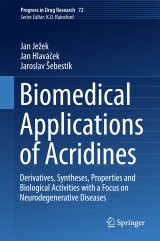Details

Biomedical Applications of Acridines
Derivatives, Syntheses, Properties and Biological Activities with a Focus on Neurodegenerative DiseasesProgress in Drug Research, Band 72
|
CHF 165.50 |
|
| Verlag: | Springer |
| Format: | |
| Veröffentl.: | 15.08.2017 |
| ISBN/EAN: | 9783319639536 |
| Sprache: | englisch |
Dieses eBook enthält ein Wasserzeichen.
Beschreibungen
<p>This book describes applications of acridines for the treatment of various neurodegenerative diseases, such as Alzheimer’s disease, Parkinson’s disease, and various prion diseases, and discusses the potential of acridines in neuro-regenerative medicine. Using modern data-mining software, it presents structures of acridines with nucleic acids and proteins and compares them with the native structures. Furthermore, the book presents modern methods of acridine synthesis, comparing them with the most useful conventional methods. Acridines interact with both nucleic acids and proteins, and due to their direct interactions with various enzymes, they can be suitable for the treatment of neurodegenerative diseases, inflammation, immunological disorders, and protozoal diseases. The characteristic spectral properties of acridines can be employed in labeling proteins, nucleic acids, lipids, and even cells and their compartments. Moreover, they can be applied in photodynamic therapy. </p>
<p>Preliminary ToC 1 Introduction.- 2 Nomenclature.- 3. Syntheses.- 4. Interactions of acridines with nucleic acids.- 5. Intercations with proteins.- 6. Applications for treament of neurodegenerative diseases.- 7. Some applications of selective toxicities of acridines.- 8. Acridine on dendrimeric carriers.- 9 Acridines used for staining.- 10 Miscellaneous.- 11 Conclusions and outlook.</p><div></div>
This book describes applications of acridines for the treatment of various neurodegenerative diseases, such as Alzheimer’s disease, Parkinson’s disease, and various prion diseases, and discusses the potential of acridines in neuro-regenerative medicine. Using modern data-mining software, it presents structures of acridines with nucleic acids and proteins and compares them with the native structures. Furthermore, the book presents modern methods of acridine synthesis, comparing them with the most useful conventional methods. Acridines interact with both nucleic acids and proteins, and due to their direct interactions with various enzymes, they can be suitable for the treatment of neurodegenerative diseases, inflammation, immunological disorders, and protozoal diseases. The characteristic spectral properties of acridines can be employed in labeling proteins, nucleic acids, lipids, and even cells and their compartments. Moreover, they can be applied in photodynamic therapy.
Describes modern and conventional syntheses of acridine scaffolds Presents structural aspects of interactions with proteins which provide useful tips for designing enzyme inhibitors involved in the treatment of neurodegenerative diseases Discusses structural aspects of interactions with nucleic acids, which helps readers to design a specific binder for the targeting of quadruplexes involved in cancer Includes supplementary material: sn.pub/extras
<p>Describes modern and conventional syntheses of acridine scaffolds</p><p>Presents structural aspects of interactions with proteins which provide useful tips for designing enzyme inhibitors involved in the treatment of neurodegenerative diseases</p><p>Discusses structural aspects of interactions with nucleic acids, which helps readers to design a specific binder for the targeting of quadruplexes involved in cancer</p><div><br/></div>

















